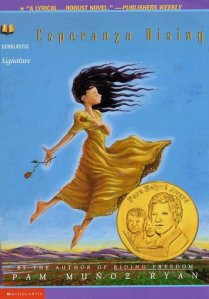
Book Cover
This is the story of Bud Caldwell, an orphan living during the Great Depression. After much adversity and repeated abuse from his foster brother Todd Amos, Bud decides to runaway from his home in Flint, Michigan. He sets out to find Herman Calloway, a supposed relative. Along the way Bud befriends a railroad porter named Lefty Lewis and Lewis offers a place for Bud to sleep. Bud eventually meets up with Herman Calloway and receives a cold welcome from Calloway. When Bud’s collection of rocks are discovered, Calloway believes that Bud has stolen them.
Insight:
This story is emphasizes good prevails (even though it is not a realistic view), even in challenging times. This book is superb. I would use this as a read aloud in class as a way to discuss determination and strength in character. Bud, Not Buddy is the recipient of the Coretta Scott King award and also the recipient of the Newbery Medal. This title is a must for an elementary school’s library collection and an essential read for any elementary student.
Suggested Library Activity:
Have students create a class newspaper focusing on different aspects of the novel’s time period. Include information on homelessness, Jazz, the Great Depression, etc. Have students gather all their research and create a newspaper to be displayed in the library for all to read.
Bibliographic Citation:
Curtis, C. (1999). Bud, not buddy. New York: Delacorte Press.
Additional Book Review:
As in his Newbery Honor-winning debut, The Watsons Go to Birmingham–1963, Curtis draws on a remarkable and disarming mix of comedy and pathos, this time to describe the travails and adventures of a 10-year-old African-American orphan in Depression-era Michigan. Bud is fed up with the cruel treatment he has received at various foster homes, and after being locked up for the night in a shed with a swarm of angry hornets, he decides to run away. His goal: to reach the man he–on the flimsiest of evidence–believes to be his father, jazz musician Herman E. Calloway. Relying on his own ingenuity and good luck, Bud makes it to Grand Rapids, where his “”father”” owns a club. Calloway, who is much older and grouchier than Bud imagined, is none too thrilled to meet a boy claiming to be his long-lost son. It is the other members of his band–Steady Eddie, Mr. Jimmy, Doug the Thug, Doo-Doo Bug Cross, Dirty Deed Breed and motherly Miss Thomas–who make Bud feel like he has finally arrived home. While the grim conditions of the times and the harshness of Bud’s circumstances are authentically depicted, Curtis shines on them an aura of hope and optimism. And even when he sets up a daunting scenario, he makes readers laugh–for example, mopping floors for the rejecting Calloway, Bud pretends the mop is “”that underwater boat in the book Momma read to me, Twenty Thousand Leaks Under the Sea.”” Bud’s journey, punctuated by Dickensian twists in plot and enlivened by a host of memorable personalities, will keep readers engrossed from first page to last. Ages 9-12. (Sept.)
Publisher’s Weekly. (1999, September 6). Book Review Bud, Not Buddy. Retrieved from http://www.publishersweekly.com/978-0-385-32306-2
Horn Book (November/December, 1999)
In a story that’s as far-fetched as it is irresistible, and as classic as it is immediate, a deserving orphan boy finds a home. It’s the Depression, and Bud (not Buddy) is ten and has been on his own since his mother died when he was six. In and out of the Flint, Michigan, children’s home and foster homes ever since, Bud decides to take off and find his father after a particularly terrible, though riotously recounted, evening with his latest foster family. Helped only by a few clues his mother left him, and his own mental list of “Rules and Things for Having a Funner Life and Making a Better Liar Out of Yourself,” Bud makes his way to a food pantry, then to the library to do some research (only to find that his beloved librarian, one Charlemae Rollins, has moved to Chicago), and finally to the local Hooverville where he just misses hopping a freight to Chicago. Undaunted, he decides to walk to Grand Rapids, where he hopes his father, the bandleader Herman E. Calloway, will be. Lefty Lewis, the kindly union man who gives Bud a lift, is not the first benevolent presence to help the boy on his way, nor will he be the last. There’s a bit of the Little Rascals in Bud, and a bit more of Shirley Temple as his kind heart and ingenuous ways bring tears to the eyes of the crustiest of old men-not his father, but close enough. But Bud’s fresh voice keeps the senti-mentality to a reasonable simmer, and the story zips along in step with Bud’s own panache. r.s.
Tags: chapter book, Great Depression, historical fiction, music, Newbery, runaway



